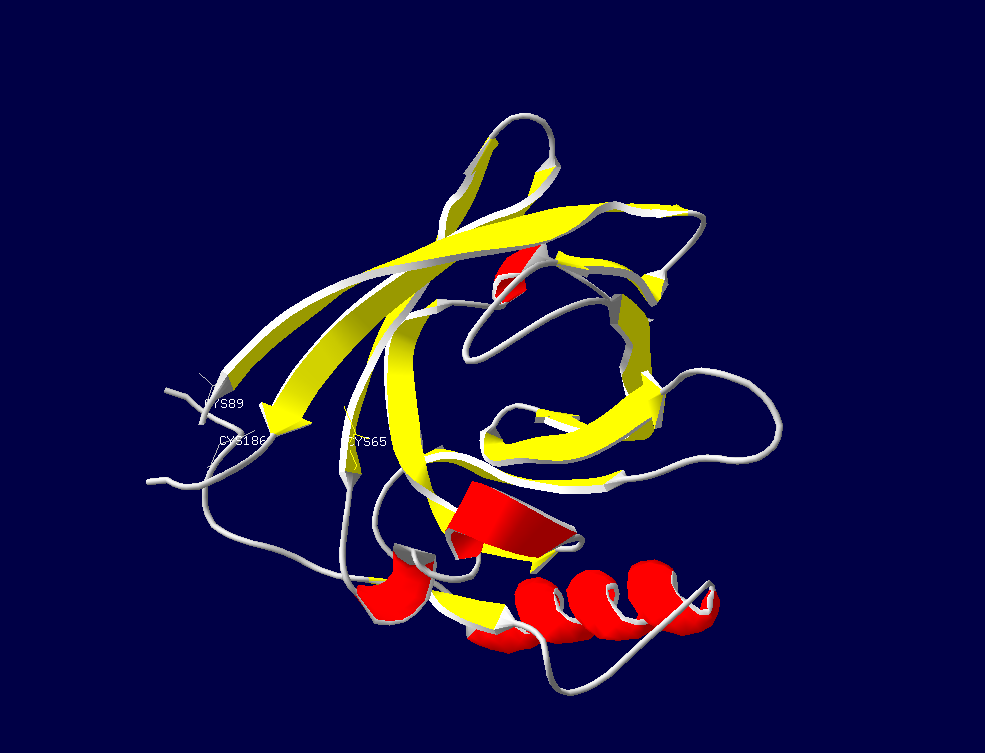Sandbox Reserved 1243
From Proteopedia
| Line 20: | Line 20: | ||
== Function == | == Function == | ||
*Ligand Binding | *Ligand Binding | ||
| - | Retinoids, bilirubin, biliverdin, and thyroid hormone with high affinities (Km = 30-80 nM) often bind to L-PGDS for transport. Transport of these molecules via L-PGDS occurs within the cerebral spinal fluid and transported to the necessary location of the central nervous system. Retinoids have been found to bind on a separate site than the prostagladin active site (Cys65 residue not necessary for retinoid binding) and can act as a noncompetive inhibitor for PGD2 synthesis and transport. | + | Retinoids, bilirubin, biliverdin, and thyroid hormone with high affinities (Km = 30-80 nM) often bind to L-PGDS for transport. Transport of these molecules via L-PGDS occurs within the cerebral spinal fluid and transported to the necessary location of the central nervous system. Retinoids have been found to bind on a separate site than the prostagladin active site (Cys65 residue not necessary for retinoid binding) and can act as a noncompetive inhibitor for PGD2 synthesis and transport. <ref>doi: 10.1074/jbc.272.25.15789</ref> |
*PGD2 Synthesis | *PGD2 Synthesis | ||
*Transport | *Transport | ||
Revision as of 20:27, 1 May 2017
| This Sandbox is Reserved from Jan 17 through June 31, 2017 for use in the course Biochemistry II taught by Jason Telford at the Maryville University, St. Louis, USA. This reservation includes Sandbox Reserved 1225 through Sandbox Reserved 1244. |
To get started:
More help: Help:Editing |
Contents |
Lipocalin-Type Prostaglandin D Synthase (L-PGDS)
|
Lipocalin-type Prostaglandin D Synthase (L-PGDS) is the second most abundant protein in the human cerebrospinal fluid. It is involved in the transport of hydrophobic molecules as well as its namesake in the production of prostaglandin D2: an unsaturated fatty acid that is involved in maintaining homeostasis, regulating sleep, aiding in inflammatory responses, and other neurological functions. Although structurally and biochemically different from hematopoietic-PGD synthase, they both take part in the arachidonate cyclooxygenase pathway to make PGD from PGH2. The smaller of the two PGD synthases, L-PGDS contains a beta-barrel structure and was initially found in the brain. It was later found in the tissues of the heart, kidneys, and lungs as well as a number of other body fluids. Inhibiting this enzyme results in the deterioration and lack of function of major organs and metabolic processes and has been found to be linked to some cancers, hair loss, and diabetes. L-PGDS can trigger both pro- and anti-inflammatory responses to the immune system, allowing its levels to be highly regulated. [1]
Function
- Ligand Binding
Retinoids, bilirubin, biliverdin, and thyroid hormone with high affinities (Km = 30-80 nM) often bind to L-PGDS for transport. Transport of these molecules via L-PGDS occurs within the cerebral spinal fluid and transported to the necessary location of the central nervous system. Retinoids have been found to bind on a separate site than the prostagladin active site (Cys65 residue not necessary for retinoid binding) and can act as a noncompetive inhibitor for PGD2 synthesis and transport. [2]
- PGD2 Synthesis
- Transport
Diseases/Malfunctions!!
It causes the entire world to explode!!!
Structural highlights
L-PGDS shares the antiparallel beta barrel structure that is common within the lipocalin protein family. The active site for the protein is embedded in this beta barrel. The Cys65 in the center of the barrel is the essential residue in the binding of the PGD2 for isomerization and other small hydrophobic molecules for transport. [3]
- Number of Residues -- 190
- pI -- 4.6
- Subunit Molecular Mass -- 27.0 k
References
- ↑ Joo M, Sadikot RT. PGD synthase and PGD2 in immune resposne. Mediators Inflamm. 2012;2012:503128. doi: 10.1155/2012/503128. Epub 2012 Jun 25. PMID:22791937 doi:http://dx.doi.org/10.1155/2012/503128
- ↑ Tanaka T, Urade Y, Kimura H, Eguchi N, Nishikawa A, Hayaishi O. Lipocalin-type prostaglandin D synthase (beta-trace) is a newly recognized type of retinoid transporter. J Biol Chem. 1997 Jun 20;272(25):15789-95. doi: 10.1074/jbc.272.25.15789. PMID:9188476 doi:http://dx.doi.org/10.1074/jbc.272.25.15789
- ↑ Urade Y, Eguchi N, Hayaishi O. Lipocalin-Type Prostaglandin D Synthase as an Enzymic Lipocalin. In: Madame Curie Bioscience Database [Internet]. Austin (TX): Landes Bioscience; 2000-2013. Available from: https://www.ncbi.nlm.nih.gov/books/NBK6621/
- ↑ Flower, D. R. (1996). The lipocalin protein family: structure and function. Biochemical Journal, 318(Pt 1), 1–14.
- ↑ doi: https://dx.doi.org/10.2210/pdb2czt/pdb
